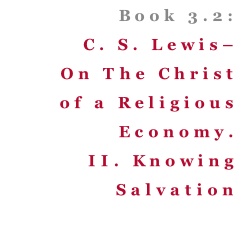

Revelation
The Christ



Outline
Contents
C. S. Lewis - On The Christ of a Religious Economy
II. KNOWING SALVATION
Part One
Revelation and Reason, Rationality and Faith–
Christ the Logos
Chapter 1 The Anscombe-Lewis Debate I: Lewis the Theologian-Philosopher–Apologetics and Method, Idealism and Platonism
Chapter 2 The Anscombe-Lewis Debate II: Naturalism and Scientism–
Causation and Logicality
Chapter 3 The Anscombe-Lewis Debate III: The Value and Limits
of Reason–Philosophical Agnosticism
Chapter 4 The Anscombe-Lewis Debate IV: Reason and
Foundationalism–Language, Meaning and a "Proof" of God?
Chapter 5 The Anscombe-Lewis Debate VI: the
analogia entis-analogia fidei–Translating Christ through Analogical Narrative
Part Two
Religion, The Church and Ministry: The Body of Christ?
Chapter 6 The Church, The Body of Christ I: The Function and Dangers of Religion–The Christ . . . and Human Religiosity.
Chapter 7 The Church, The Body of Christ II: Lewis's Doctrine of the Church.
Chapter 8 The Church, The Body of Christ III: Ecclesiology and Ministry.
Part Three
The Sufferance of Salvation - Immanuel, Christ With Us
Chapter 9 Shadows and Echoes of Eternity I: Atonement–
Blood and Substitution, Punishment and Debt.
Chapter 10 Shadows and Echoes of Eternity II: Atonement–
Incarnation and Salvation, Actuality and Justification.
Chapter 11 Shadows and Echoes of Eternity III: The Eschaton–
Election and Predestination, Decision and Faith
Chapter 12 Shadows and Echoes Of Eternity IV: The Eschaton–
Heaven and Hell, Purgation and Infernal Voluntarism
Chapter 13 Shadows and Echoes of Eternity IV:
Intimations through the Veil–Sanctification, Resurrection,
and the New Creation.
Chapter 14 Shadows and Echoes of Eternity IV:
Intimations through the Veil–Defined and Redeemed by Love
Conclusion
Bibliography and Indices



On The Christ of a Religious Economy
II. Knowing Salvation.
Each chapter is subdivided into multiple sections
and sub-sections. Click here for a detailed contents :
PDF : C.S. Lewis - On The Christ of a Religious Economy
II. Knowing Salvation
C.S. Lewis: Revelation and the Christ, Book 3.2
C. S. Lewis – On The Christ of a Religious Economy
II. Knowing Salvation
Part One Revelation and Reason, Rationality and Faith – Christ the Logos
Part One (chapters 1–5) is about the Anscombe-Lewis debate: the theological issues relating to revelation and reason, not just the philosophical questions. Noted for its impact on Lewis by supporters and detractors alike, the Anscombe-Lewis debate was about the fundamental philosophical propositions that underpin Christianity.
Lewis was a trained philosopher who valued reason as the organ of truth: Christianity was inherently rational – therefore, underpinning all of Lewis’s work is a symbiotic relationship between revelation and reason. Understanding the Anscombe-Lewis debate in 1948 is essential to appreciating Lewis’s use of reason and logicality in relation to metaphysics, causation and language. By drawing on Lewis’s Platonic Idealism, and the youthful proximity of his thought to that of the seventeenth century Cambridge Platonist Henry More and the eighteenth century philosopher Bishop George Berkeley, we can assess Lewis’s analysis of Scientism and Naturalism in Miracles (1st edition 1947).
The debate was about the fundamental philosophical propositions that underpin Christianity; but more than that, it illustrates and defines a point where Lewis’s work changes, a shift in his theological method. From a philosophical perspective the debate centres on Lewis’s censure of Naturalism and Scientism. Anscombe’s criticism of Lewis’s key argument against Naturalism (the argument from reason) revealed a minefield in terms of causation and our use of language, however, Lewis’s response (the rewriting of Miracles, 2nd edition, 1960) illustrates his mature theological understanding of revelation and reason, and thereby foundationalism. Underpinning Lewis’s work is a symbiotic relationship between revelation and reason; Lewis did not see a dichotomy between the two: religion is rational, and reason is religious – importantly, reason precedes nature, it does not issue from nature.
It is intended to demonstrate how Lewis’s championing of apologetics through the analogia entis (the analogy of being) in the 1930s and 1940s takes a more cautious, reflective and nuanced line in the 1950s; reason is complemented by wisdom though his use of the analogia fidei (the analogy of faith). Essentially this contradicts the critics who assert that, following the debate, Lewis abandoned rational apologetics for children’s stories. This shift in method is gradual, a development from the analogia entis to the analogia fidei, not necessarily triggered by the debate alone (perhaps accelerated), but a fuller development and use of a method already present. Reason and imagination now reveal of God’s purposes and truth through word pictures and narrative-faith leads to understanding (fides quaerens intellectum), faith is the ground from which reason can work. This relates closely to a concern for Christlikeness (which is consistently evidenced in his mature work): can analogical narrative tell us more of the truth of revelation than philosophical discourse?
Part Two Religion, The Church and Ministry: The Body of Christ
Part Two (Chapters 6–8) considers Lewis’s ecclesiology in its broadest sense, centred on the question, is the Church the Body of Christ? Therefore we need to examine Lewis’s doctrine of religion, particularly in its purpose and function—that is, where is religion leading (what is its teleology, for Lewis). What value can we place on religion? What are the pitfalls of religion (Matthew 7:21?). Defining religion for Lewis leads us to the Church. Lewis commented that the whole purpose of the Church was to make little Christs out of people, if not, then the whole function of Cathedrals and churches, choirs and clergy, liturgy, missions and the Christian religion, was of no point, no value. In making little Christs out of people—fallen humanity—salvation is enacted. Religion did not exist for its own sake alone: where is it leading, what is its purpose? Lewis valued religion, it held an immense role in human salvation, but it was also one of the most dangerous products of humanity. What does Lewis have to say about religion?
Defining religion for Lewis leads us to the Church. What was Lewis’s understanding of the Church? What was his doctrine of the Church—his ecclesiology. That is, the Church in its specific sense, the church we see and know, and recognise as church. This is the Christ of a religious economy, but this is also the Church as the body of Christ. What does Lewis have to say about Church authority—specifically post-Reformation? Lewis’s understanding of the Church here on earth is Augustinian (grounded essentially in the “two cities”) in the sense of both visible and invisible (that is, the ecclesia visibilis-ecclesia invisibilis): is what we take to be the Church really the Church? What does this mean for Lewis’s understanding of the Church around him, for his relationship with the community of Christ, and how does he express this in his writings? Lewis’s understanding is of the eschatological Church—but unlike many theologians (who project an over-realized eschatology) this is a balanced eschatology between now and the what-is-to-come: “we are very members incorporate in the mystical body of thy Son, which is the blessed company of all faithful people.” Where is the Church in Narnia? There are no church buildings, no liturgy as such, though most Narnians follow, respect, the Aslan-Christ. There is religion in Narnia (the Stone Table, but also the cult of Tash in Calorman for example). What does the implicit, invisible, Church in Narnia tell us about the Church in our reality, but also Lewis’s ecclesial stance?
Lewis on ministry: What can we understand about Christian ministry from the writings of C. S. Lewis? It is impossible to consider such a question outside of Lewis’s ecclesiology, his doctrine of religion, and his own conversion. If Lewis’s understanding of the Church was Augustinian (the visible and invisible) then for Lewis the two co-exist in the ministry and witness of the orthodox faithful, which marginalizes, to a degree, church structures. Ministry for Lewis is inherently evangelical. Ministry for Lewis is defined as praeparatio evangelica: the human can only prepare for the action and authority of the Holy Spirit in the ministered-to. Salvation is, therefore, the measure of church activity and ministry, which often leaves some specifically Anglican priests/ministers deficient in their office and work, vocation and spiritual service, when measured against the mere core of orthodox tradition. For Lewis, Christian ministry is more than religious therapy. Ministry, as with church activities, must, be subject to a severe criticism, yet positive valuation (implicitly, this reflects the German concept of Aufhebung – a raising up and putting down) because of the primary and overwhelming importance in human affairs and salvation history of ministering—but it is Christ who ministers, through the human.
Part Three The Sufferance of Salvation – Immanuel, Christ With Us
Part Three (chapters 9–14) considers the end times (the eschaton), the what-is-to-come, through the salvation wrought on the Cross: death judgement, heaven and hell. Examining Lewis on religion and Church leads into the question of atonement, and with it what is meant by substitution and redemption, essentially Christ’s work on the Cross. What did Lewis say of humanity in relation to God, now Immanuel God with us, incarnate, crucified and resurrected for us? What was Lewis’s understanding of atonement – i.e. how salvation through the Cross works. Lewis is essentially neutral towards all the multifarious and often seemingly contradictory doctrines of atonement and theories about the Cross; differing or competing theories of atonement are not necessarily to be seen as a flaw – Christians are not committed to one single way of understanding the meaning of the cross, because looking at the Cross as God’s love and forgiveness is sufficient at the beginning of the Christian pilgrimage. Atonement theories are a minefield, for Lewis, so that a full and complete understanding of how atonement works is probably beyond humanity. However, Lewis cannot avoid some sense of atonement theory; for Lewis this is characterised by the “classic” model, as outlined in Gustav Aulen’s Christus Victor.
Lewis’s approach to judgement, heaven and hell, is essentially Arminian (i.e. after the Reformation theologian Jacob Arminius) – all are potentially saved, some however, choose to exclude themselves, they prefer hell to heaven. For Lewis, the Gates of Hell are locked, bolted, double bolted, from the inside. Does this weaken God’s judgement? Can humanity hold out against the will of God? How does this affect election? The Last Battle and The Great Divorce illustrate Lewis’s thinking (including the inherent contradictions between the two works). It is therefore imperative to consider Lewis’s doctrine of atonement, salvation and election together.
This relates to Lewis’s own end and his belief in purgatory as of the loving actions of Christ. Therefore we scrutinize Lewis’s invocation of the shadows of eternity, intimations through the veil of this world of the life to come revealed through Christ. Lewis’s theology grew out of his personal experience of God in Christ: the death from cancer of his mother (in 1908), which contributed to his loss of faith (the clearing out, perhaps, of a false god?), his conversion back to faith (to theism in 1929, and to Christ in 1931), and then the death of his wife Joy Davidman, again from cancer (1960), are all to be considered. The conversion he underwent to a deeper level of possession in/by Christ after Joy’s death is to be seen as reflecting an understanding of reconciliation in Christ – the psychology of Atonement – built upon the Cross.
Lewis’s doctrine of atonement and salvation relates closely to his own conversion, therefore we need to decide on the validity of this experience. Was this really no more than a fantasy, wish fulfilment? Armand Nicholi’s comparison of Freud and Lewis will demonstrate otherwise. All these events in Lewis’s life are significant pointers which afford evidence of Lewis’s appropriation of Christ’s redemption. An examination of the epitaph on Lewis’s tombstone (“Men must endure their going hence,” King Lear V ii), which related to his mother’s death, also the epitaph on Joy’s grave (“Here the whole world – stars, water, air, and field, and forest, as they were reflected in a single mind – like cast off clothes was left behind in ashes, yet with hopes that she, re-born from holy poverty, in Lenten lands, hereafter may resume them on her Easter Day”), establish an element at the heart of Lewis’s Christology. We may term this element, the sufferance of salvation: without Christ, suffering is meaningless – Christ’s love beckons us to endure our suffering for His sake. Therefore we must consider precisely what the imago christi (the likeness, the image, the echo of Christ in, and to us) and the imitatio christi (the imitation of Christ, our faltering attempts at Christlikeness, initiated and driven preveniently by the Holy Spirit) was for Lewis. This was perhaps best explained by Lewis in a sermon on salvation, atonement, and reconciliation and the love and beauty that is of God from 1941, The Weight of Glory.
Download this essay in PDF:
PDF :: C.S. Lewis–On The Christ of A Religious Economy. II. Knowing Salvation.
If citing this essay please use the following:
P.H. Brazier, ‘C.S. Lewis–On The Christ of a Religious Economy. II. Knowing Salvation’
www.cslewisandthechrist.net/csl_the_christ_of_a_religious_economy_2.html.
and then give paragraph numbers and date accessed
PDF:



Home
Book One
Book Two
Book Three
Book Four
Links
Contact
“In the Highest Degree”








Author

